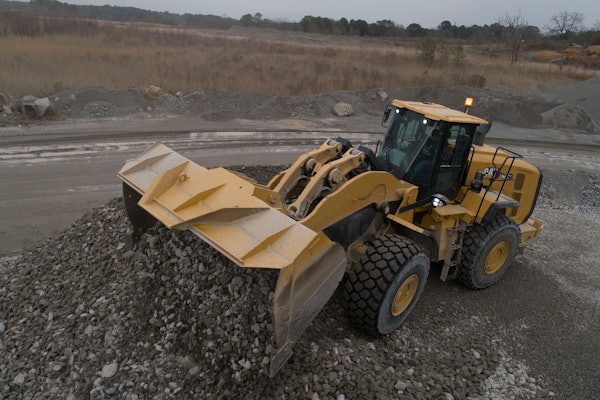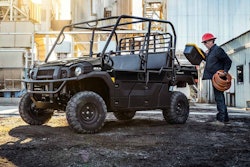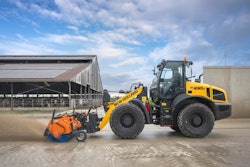The backhoe is the machine that launched a thousand earthmoving companies. But to run a company profitably, especially if you’re an owner operator, you have to know exactly how much a backhoe is costing you per hour in order to charge correctly for your services.
To get an accurate picture of the owning and operating costs of today’s backhoes John Deere Construction Equipment put together a multi-disciplinary team including Bob Tyler, marketing manager for backhoes, Luke Kurth, product comparison manager for construction equipment, Bill Connolly, manager of finance integration for John Deere Credit, Diego Navarro, service manager for construction and forestry, and Terry Oftedal, senior staff engineer.
Note that all the figures we cite in this article – dollars, hours and predicted lifecycles – are just ballpark averages. These will vary greatly depending on the make and model of backhoe, applications, duty cycles, soil types, operator skill and dozens of other variables. To get an accurate figure for your jobs you need to go through this exercise and plug in your own numbers. Deere’s dealers can provide a spreadsheet program that makes this relatively simple. And don’t forget that your O&O costs are just one part of your hourly rates. You also have to figure in your overhead, projected profits, taxes and other business expenses.
OWNING COSTS
The backhoe we chose for this exercise is the Deere Model 310 SJ, the company’s best selling model. Tyler pegs the purchase price of a new 310 SJ at around $75,000 but cautions it could go $10,000 higher or lower with just a few option changes. This price represents a backhoe with a heated and air-conditioned cab and auxiliary hydraulic plumbing for a hammer on the back. That’s an upgrade from a bare bones model the rental fleets usually spec. Additional upgrades within this price range include things like a four-wheel-drive transmission and an extendable stick. A fully loaded backhoe with all the bells and whistles may run as much as double the bare-bones price, Tyler says.
For the lifecycle, Tyler says four years is typical; and on average contractors put about 900 hours on a backhoe in a year. “We design them for 10 years and beyond, but if you have financing, four years is a good age to turn a backhoe over,” he says.
The trade-in value for a backhoe in this class at four years/3,600 hours varies depending on if the machine is for sale, will be used as a trade-in or be sold at an auction and its condition. For the 2004 year 310 SJ, Tyler cites two numbers: $39,680 for an auction average and $55,380 as a sale price. We’ll split the difference and average the two numbers to peg it at $47,530.
Government CostS
Taxes, title and insurance are an important part of your O&O calculations but taxes and other government paperwork costs vary widely from state to state, Connolly says. The tax implications of this kind of capital purchase have also changed due to the current bonus depreciation allowance in the federal government’s economic stimulus plan. These figures are best decided between you and your accountant or tax advisor.
Damage insurance for this model runs about $500 a year. And financing costs about 2 to 5 percent per year of the machine’s total cost, says Connolly.
If you’re comparing used to new backhoes, it’s worth noting that the Tier 3 off-road engines that Deere puts into today’s backhoes are not more expensive than the earlier Tier 2 engines, and are getting about the same fuel economy, says Oftedal. For interim Tier 4 engines in 2011 and full Tier 4 engines in 2015, it’s still too early to tell, he says, but the goal is to keep the cost and the fuel economy the same or better.
OPERATING COSTS
Wages: The biggest operating cost for a backhoe, or any piece of construction equipment, is what you pay the operator. Wages vary from about $13 to $40 an hour depending on the region. The average operator will pull down about $20 an hour for pay and $11 an hour for benefits, Kurth says.
Diesel: Fuel is the next big expense. The 310 SJ has a range of between 1.4 and 2.2 gallons per hour depending on how hard the engine is working, Tyler says. When you’re craning a manhole cover or carefully digging around utilities, you’re not using as much fuel as when you’re truck-loading at full rpm.
For the purposes of this discussion we pegged the price of diesel at $3.50 a gallon, which works out to a range of $4.90 to $7.70 an hour. Since backhoes work in a variety of applications, we split the difference and came up with $6.30 an hour. For backhoes that have them, auto-idle systems automatically return the engine rpms to a low level after a period of inactivity and improve fuel efficiency. Having accurate records of your own fuel usage will help you refine this number for your calculations.
PM: Like the other figures, preventive maintenance varies, but since this figure varies less than most, Deere provides an average in its spreadsheet. Parts, including oil, filters and grease come to 49 cents per operating hour or $440 per year. A mechanic’s labor is calculated at $75 an hour and works out to $1.36 per operating hour and $1,224 per year. All totaled, PMs work out to $1.85 per operating hour or $1,665 per year.
The PMs for this machine are set at 500-hour engine oil changes and 2,000-hour hydraulic oil changes, Kurth says. If you do oil sampling and the oil shows it’s holding up well you may be able to extend that engine oil interval to 1,000 hours, cutting those costs in half. Kurth recommends getting the optional oil sampling port installed on the machine to make it easier to pull a clean sample. By-pass filtration of engine and hydraulic oils can also extend PM intervals as well as component life, Navarro says.
Tires: Even though they come with the backhoe, tires are treated as an operating expense and subtracted from the purchase price and owning costs of the machine. Tires for this model typically cost from $2,850 to $3,000 for two-wheel drive. Kurth says. (If you’re spec’ing a four-wheel-drive model, tires are priced closer to about $3,600, Tyler says.)
Consumables: Bucket teeth and edges can last the lifetime of the machine, or be worn away in a week, says Kurth. It depends on the abrasiveness of the soil and the severity of the application. A set of digging teeth cost about $50 and a bucket cutting edge runs about $225. To keep it real, we factored in one of each for the lifecycle.
Technology tip
Optional machine tracking and monitoring systems were not built into our cost calculator, but they can help lower some costs. By monitoring fuel consumption you can tell if a backhoe is idling too much or if one operator is using more fuel than another doing a comparable job, Navarro says.
By monitoring engine temperatures and pressures you can also keep tabs on the health of a machine and get early warning on problems. This improves the uptime and allows you to react fast enough to fix problems before they get too big, Navarro says. Geofencing, which notifies the owner of any unauthorized transport or use of a machine, deters theft and can prevent others from taking the machine home on weekends to work on personal projects, Navarro says.









